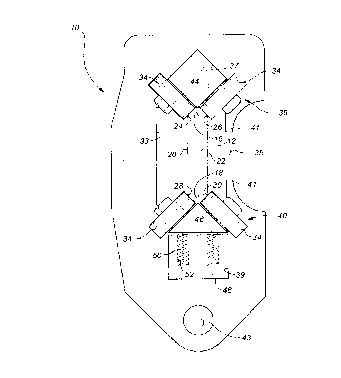Some of the information on this Web page has been provided by external sources. The Government of Canada is not responsible for the accuracy, reliability or currency of the information supplied by external sources. Users wishing to rely upon this information should consult directly with the source of the information. Content provided by external sources is not subject to official languages, privacy and accessibility requirements.
Any discrepancies in the text and image of the Claims and Abstract are due to differing posting times. Text of the Claims and Abstract are posted:
| (12) Patent: | (11) CA 2121651 |
|---|---|
| (54) English Title: | TRACK AND RAIL-FORM SLIDER COMBINATION |
| (54) French Title: | CHEMIN DE ROULEMENT ET PIECE COULISSANTE COMBINES |
| Status: | Expired and beyond the Period of Reversal |
| (51) International Patent Classification (IPC): |
|
|---|---|
| (72) Inventors : |
|
| (73) Owners : |
|
| (71) Applicants : |
|
| (74) Agent: | NATHAN V. WOODRUFFWOODRUFF, NATHAN V. |
| (74) Associate agent: | |
| (45) Issued: | 1999-11-30 |
| (22) Filed Date: | 1994-04-19 |
| (41) Open to Public Inspection: | 1994-09-25 |
| Examination requested: | 1996-01-30 |
| Availability of licence: | N/A |
| Dedicated to the Public: | N/A |
| (25) Language of filing: | English |
| Patent Cooperation Treaty (PCT): | No |
|---|
| (30) Application Priority Data: | None |
|---|
A track and rail-form slider combination is described which includes a rail-form slider having a top surface, a bottom surface, and sides extending between the top surface and the bottom surface. Pour corners are formed where the top surface meets the sides and the bottom surface meets the sides. A track is provided which includes a plurality of roller supports. At least four rollers are secured to each roller support. Each roller engages the rail-form slider solely at one of the corners.
Un chemin de roulement et une pièce coulissante combinés sont décrits qui comportent une pièce coulissante ayant une surface supérieure, une surface inférieure, et des côtés s'étendant entre la surface supérieure et la surface inférieure. Des angles de versement sont formés à l'emplacement où la surface supérieure touche les côtés et où la surface inférieure touche les côtés. Un chemin de roulement est prévu qui comporte une pluralité de supports de roulement. Au moins quatre roulements sont fixés à chaque support de roulement. Chaque roulement n'entre en contact avec la pièce coulissante que dans les angles.
Note: Claims are shown in the official language in which they were submitted.
Note: Descriptions are shown in the official language in which they were submitted.

2024-08-01:As part of the Next Generation Patents (NGP) transition, the Canadian Patents Database (CPD) now contains a more detailed Event History, which replicates the Event Log of our new back-office solution.
Please note that "Inactive:" events refers to events no longer in use in our new back-office solution.
For a clearer understanding of the status of the application/patent presented on this page, the site Disclaimer , as well as the definitions for Patent , Event History , Maintenance Fee and Payment History should be consulted.
| Description | Date |
|---|---|
| Time Limit for Reversal Expired | 2014-04-22 |
| Letter Sent | 2013-04-19 |
| Inactive: Late MF processed | 2012-06-15 |
| Letter Sent | 2012-04-19 |
| Appointment of Agent Requirements Determined Compliant | 2011-05-03 |
| Inactive: Office letter | 2011-05-03 |
| Revocation of Agent Requirements Determined Compliant | 2011-05-03 |
| Inactive: Office letter | 2011-04-28 |
| Small Entity Declaration Determined Compliant | 2009-03-04 |
| Small Entity Declaration Request Received | 2009-03-04 |
| Inactive: Late MF processed | 2008-06-30 |
| Inactive: Correspondence - Formalities | 2008-06-30 |
| Letter Sent | 2008-04-21 |
| Inactive: IPC from MCD | 2006-03-11 |
| Grant by Issuance | 1999-11-30 |
| Inactive: Cover page published | 1999-11-29 |
| Small Entity Declaration Determined Compliant | 1999-09-13 |
| Inactive: Final fee received | 1999-09-13 |
| Inactive: Received pages at allowance | 1999-09-13 |
| Pre-grant | 1999-09-13 |
| Letter Sent | 1999-03-12 |
| Notice of Allowance is Issued | 1999-03-12 |
| Notice of Allowance is Issued | 1999-03-12 |
| Inactive: IPC assigned | 1998-03-02 |
| Inactive: IPC assigned | 1998-03-02 |
| Inactive: IPC removed | 1998-03-02 |
| Inactive: First IPC assigned | 1998-03-02 |
| Inactive: Approved for allowance (AFA) | 1998-01-29 |
| Inactive: Status info is complete as of Log entry date | 1997-11-05 |
| Inactive: Application prosecuted on TS as of Log entry date | 1997-11-05 |
| All Requirements for Examination Determined Compliant | 1996-01-30 |
| Request for Examination Requirements Determined Compliant | 1996-01-30 |
| Application Published (Open to Public Inspection) | 1994-09-25 |
There is no abandonment history.
The last payment was received on 1999-02-22
Note : If the full payment has not been received on or before the date indicated, a further fee may be required which may be one of the following
Patent fees are adjusted on the 1st of January every year. The amounts above are the current amounts if received by December 31 of the current year.
Please refer to the CIPO
Patent Fees
web page to see all current fee amounts.
Note: Records showing the ownership history in alphabetical order.
| Current Owners on Record |
|---|
| GOLDEN ROD WELDING LTD. |
| Past Owners on Record |
|---|
| DARRELL DOHERTY |